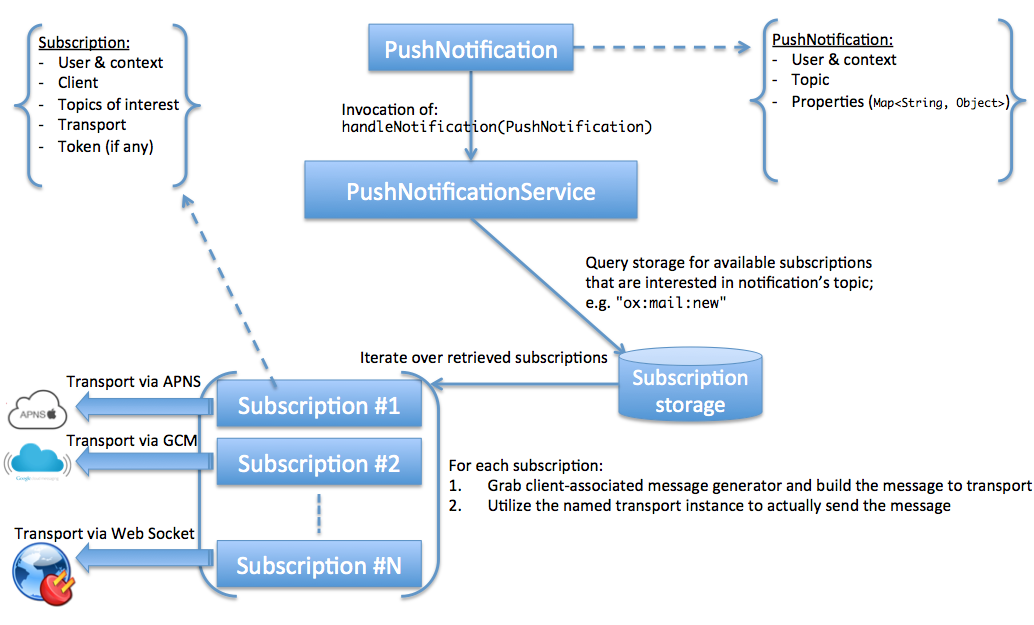Push Notification Service deprecated
Introduction
Starting with v7.8.3 the Open-Xchange Middleware implemented a generic Push Notification Service that supports delivering arbitrary user-associated push notification messages to multiple clients in a transport-agnostic way.
Big picture

How it works
Several event-trapping locations inside the Open-Xchange Middleware are allowed to pass messages consisting of a topic name and arbitrary associated properties to the OSGi singleton service com.openexchange.pns.PushNotificationService. For instance, the listeners for new incoming mails pass a message with topic "ox:mail:new" along-side with (at least) associated mail folder.
Then that service looks-up every existing explicit or implicit subscriptions for every client that signals interest for notification's topic. A subscription provides for a certain user/client pair:
- The topics of interest; one/multiple identifiers or using a wild-card notation; e.g.
"ox:mail:*" - The transport to use
- The token to use (if any)
The payload is created according to client-associated message generator and finally sent out using the subscriptions' channels (be it APNS, FCM or Web Sockets) to the client end-points.
Hence, in order to let a certain client for a user receive notifications for a topic, an explicit or implicit subscription needs to exist that advertises interest for notification's topic. That subscription specifies the identifier of the transport as well as the to use. In addition, a dedicated implementation of com.openexchange.pns.PushMessageGenerator needs to be OSGi-wise registered, which is responsible for yielding the appropriate message that is transported using specified transport channel to that certain client.
Explicit subscription
An explicit subscription is created by invoking com.openexchange.pns.PushSubscriptionRegistry.registerSubscription(). The subscription is permanently stored to database and associated tables are queried on incoming notifications. This is the suitable way (using the /ajax/pns?action=subscribe HTTP request) for mobile clients that are supposed to receive push notifications from a cloud push service.
Implicit subscription
An implicit subscription can be advertised through implementing and OSGi-wise registering an instance of com.openexchange.pns.PushSubscriptionProvider. For instance, due to the volatile nature of Web Sockets, there is no permanent subscription (and unsubscription), but an instance of com.openexchange.pns.PushSubscriptionProvider that simply checks if there is any open Web Socket for notification-associated user and signals that there is an interested subscription (provided that notification's topic fits into Web Socket processable messages)
Web Socket transport
The Web Socket transport needs special attention. As outlined above dealing with Web Sockets required to register an appropriate instance of com.openexchange.pns.PushSubscriptionProvider since writing to/deleting from persistent subscription storage might be too frequent according to a Web Sockets volatile life cycle.
Moreover, a client association of a Web Socket is determined by the path used when the Web Socket was established. Hence, a client that is supposed to receive push notifications via Web Sockets needs an accompanying instance of com.openexchange.pns.transport.websocket.WebSocketToClientResolver. That instance needs to be OSGi-wise registered and lets the Web Socket specific implementation of com.openexchange.pns.PushNotificationTransport resolve to what client an open Web Socket belongs to and what path filter expression to use when trying to send a message to exactly that client.
For instance, Socket.IO compatible Web Sockets are established using "/socket.io/" path information in the upgrade request:
GET /socket.io/?session=XYZ HTTP/1.1
Host: my.open-xchange.invalid
Upgrade: websocket
Connection: Upgrade
Sec-WebSocket-Key: x3JJHMbDL1EzLkh9GBhXDw==
Sec-WebSocket-Version: 13
Origin: http://open-xchange.invalid
The associated instance of com.openexchange.pns.transport.websocket.WebSocketToClientResolver announces that path "/socket.io/" is linked to client "open-xchange-appsuite" and path filter expression "/socket.io/*" is supposed to be used when attempting to send a message to App Suite UI.
